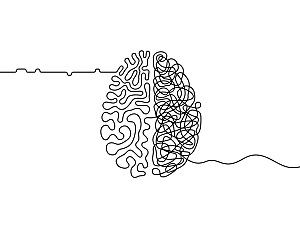Depression is one of the most common and debilitating complications reported by patients with multiple sclerosis (MS)—not just because of poorer health-related quality of life, but because the disease damages focal areas in the brain. The severity of depression increases with the progression of MS, and serotonergic antidepressants are only modestly effective.
Researchers at Brigham and Women’s Hospital recently demonstrated that lesions causing depression in 461 patients with stroke or penetrating head trauma were functionally connected to a common brain circuit. Also, depression improved after transcranial magnetic stimulation (TMS) to the positive parts of the circuit or deep brain stimulation (DBS) to the negative parts.
Shan H. Siddiqi, MD, a neuropsychiatrist, and Isaiah Kletenik, MD, a neurologist, in the Brigham’s Center for Brain Circuit Therapeutics and the Center for Brain/Mind Medicine, Michael D. Fox, MD, PhD, a neurologist who directs the Center and serves as Kaye Family director of the Psychiatric Brain Stimulation Program, and colleagues have now extended the findings. In Nature Mental Health, they report MS lesions associated with depression are preferentially connected to the previously identified brain circuit, which should make it possible to identify treatment targets.
Methods
The longitudinal SysteMS study at the Brigham is designed to identify clinical and radiologic factors associated with MS severity and progression. The current analysis included 281 participants enrolled between November 2015 and September 2017.
At enrollment the participants underwent MRI, completed the Neuro-QoL self-report inventory of 12 neuropsychiatric symptom clusters, and completed the Expanded Disability Status Scale.
MS Lesions and the Depression Circuit
Patients with lesions more closely connected to the previously identified depression circuit had higher scores on the Neuro-QoL depression subscale independent of age, sex, overall disability, and total lesion volume (r=0.15; P = 0.013).
The relationship was confirmed to be specific to depression compared with the 11 other Neuro-QoL metrics and overall disability (P=0.0058). It was also evident after additional adjustment for fatigue and cognitive symptoms, and common neuropsychiatric comorbidities of MS depression (r=0.16; P = 0.0075).
Convergence Across Lesion Etiologies
The depression circuit derived from the 281 patients with MS aligned well with the depression circuit derived earlier from stroke and penetrating head trauma lesions (r=0.51; P=0.04).
Convergence Between MS Depression and Brain Stimulation Sites
The MS depression circuit also aligned with:
- A brain circuit for improvement in depression derived from 151 TMS sites in people treated for major depressive disorder (r=0.62; P=0.009)
- A brain circuit derived from 101 DBS sites in people treated for major depressive disorder (MDD), Parkinson’s disease, or epilepsy (r=0.68; P=0.002)
MS Depression Circuit Peak
Negative connectivity between lesion locations and the ventral midbrain, including the ventral tegmental area (VTA), was the strongest association with MS depression. The VTA is the source of dopamine in the mesolimbic reward system, and both reward processing and dopaminergic neurotransmission are affected in people with MS.
Multiple Therapeutic Implications
The finding that MS depression shares some neuroanatomical features with other depression etiologies suggests it may respond to the same TMS targets as primary MDD and post-stroke depression. Future clinical trials should investigate the antidepressant efficacy of TMS in people with MS.
Several antidopaminergic and dopaminergic drugs are effective for unipolar or bipolar depression, such as aripiprazole, lurasidone, bupropion, and selegiline. Although highly speculative, the study results suggest these medications are worth exploring in MS depression.
